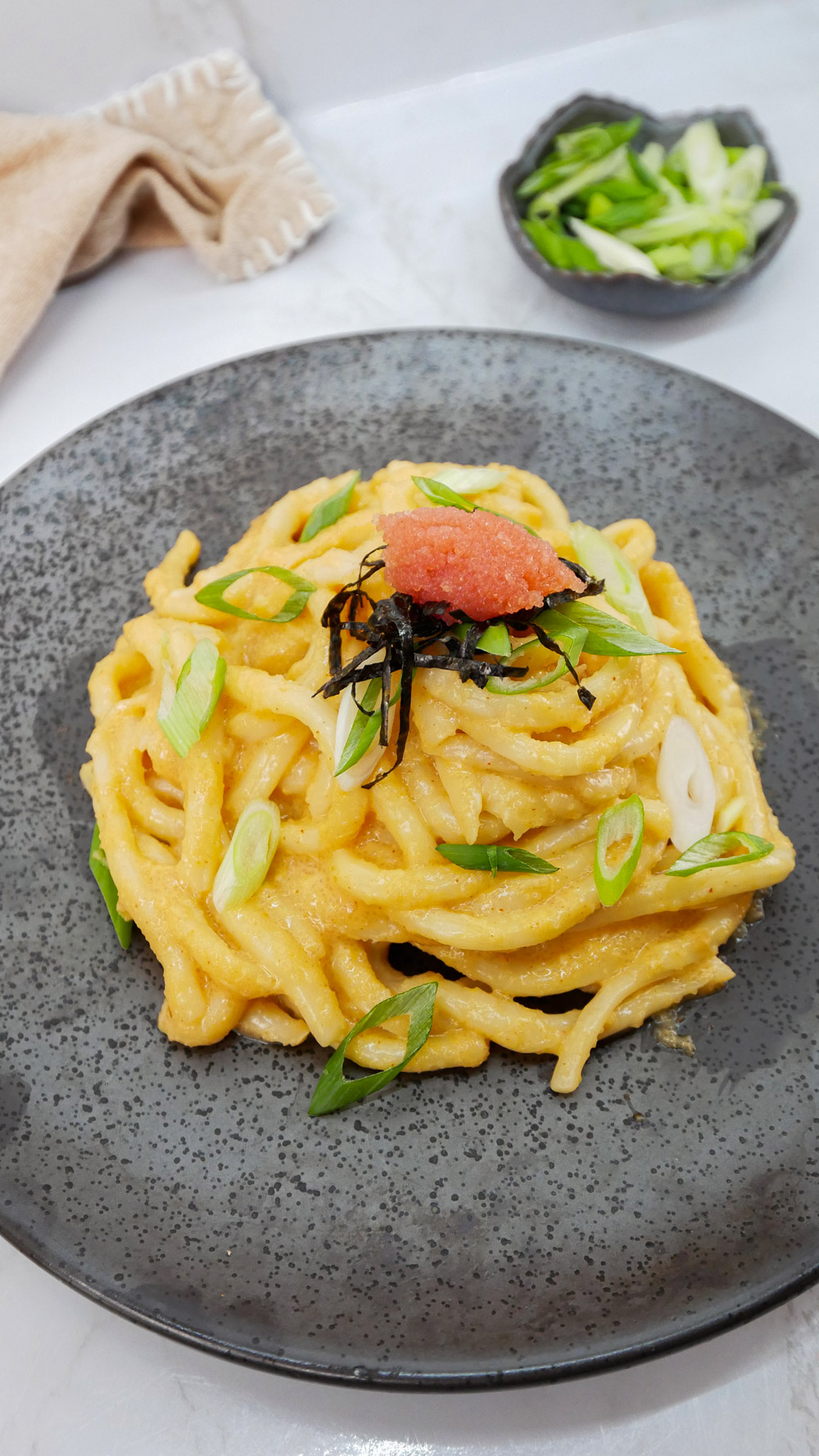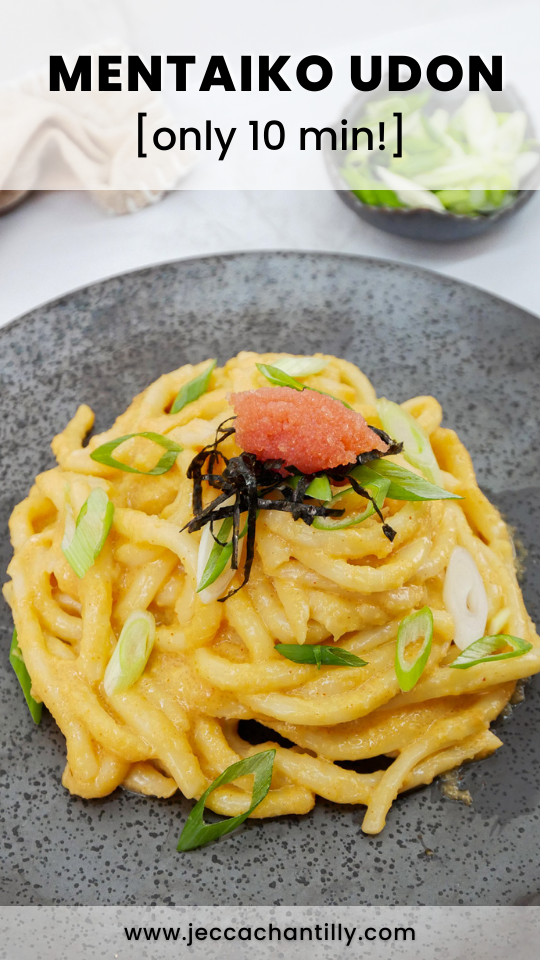This creamy and indulgent mentaiko udon comes together in just 10 minutes – yes, 10 minutes! If you’re not familiar with mentaiko, it is a Japanese seafood that’s made from fermented cod or pollock roe (eggs). Mentaiko is also called ‘myeongran-jeot’ in Korean, which is where it originated from. They can usually be found in the frozen section at your local Korean or Japanese market.
Since mentaiko or myeongran-jeot is fermented, it’s full of umami and packed with flavor. When added to the sauce for this udon recipe, it results in a delicious and indulgent meal. Best of all, it’s incredibly easy to prepare! I love having quick and easy meals like this in my back pocket for days when I crave maximum flavor and minimum effort.
Save this recipe for the next time you’re in a pinch, and give it a try. I think you’ll LOVE it!
Why you’ll love this recipe
This recipe is far from your typical udon dish because it’s packed with rich and umami flavors that you’ll want to put on repeat!
The secret ingredient in this dish is none other than *gochujang*. While the addition of this Korean red chili paste is not traditional in Japanese cooking by any means, I think it adds another layer of spice and depth of flavor that complements the fish roe quite nicely.
For an extra touch of creaminess and richness, heavy cream is used as the base for the sauce. It allows the umami and spicy flavors of the mentaiko to shine while creating a thick beautiful sauce. A dollop of kewpie mayo also provides a hint of tangy and sweet flavors that round out the overall taste of the dish.
If you have extra mentaiko or myeongran-jeot and need some inspo for another quick, easy, and delicious meal, check out my Mentaiko Pasta recipe!
Ingredients & Substitutions
Mentaiko: considering mentaiko is the star ingredient of this recipe and provides most of the flavors, I recommend sourcing the highest quality mentaiko you can find.
Soy sauce: soy sauce adds an umami and salty taste to the mentaiko. Keep in mind take mentaiko is quite salty so be sure to adjust and taste the soy sauce as you go. I used the Sempio brand for this recipe but you can use any brand you prefer.
Mirin: mirin provides a subtle sweet and tangy flavor to the mentaiko. You can substitute it with sake or skip it in a pinch.
Fresh udon packet: fresh udon noodles are chewy and cook faster than dried udon noodles, but you can substitute them with the latter if you can’t get them fresh. Frozen udon also works too!
Butter: butter makes the udon sauce rich and creamy. Butter can be substituted with any neutral-tasting oil.
Garlic clove: garlic clove adds a delicious garlicky flavor and aroma that enhances the overall flavors of the mentaiko udon. Feel free to use as much garlic as you like!
Heavy cream: heavy cream is the base of the sauce and adds a luxuriously thick and creamy consistency. For a lighter sauce, substitute the heavy cream with half and half.
Gochujang: gochujang is Korean fermented red chili paste. It’s the secret ingredient that adds a spicy, salty, and umami twist. A little is all you need but I promise it makes a big difference!
Kewpie mayo: kewpie mayo is a Japanese mayo that adds creaminess and richness to the sauce. I prefer Japanese mayo over regular mayo because it is richer and slightly sweeter. However, if you don’t have Kewpie mayo, you can just use regular mayo.
Scallions: scallions add freshness and an oniony kick. Also used for garnish!
Nori strips: adding nori strips as garnish is completely optional, but they add an umami taste that elevates the flavors of the dish.
Ingredient Additions/Variations
If you want to take this recipe up a notch to dangerously delicious levels, here are a few ingredients that would complement this dish.
- Seafood – if you’re a big fan of the flavors of the ocean, you can turn this mentaiko udon into the ultimate seafood lovers’ dream! You can add shrimp, squid, scallops, or crab for a medley of flavors.
- Perilla leaves – perilla leaves may be an unusual addition to this dish, but their distinct flavor is a refreshing complement to the umami and spicy flavor of the mentaiko udon. You can slice them into thin strips and garnish on the dish.
- Coconut cream – if the cream-based sauce stops you from making this dish, you can substitute the heavy cream with coconut cream for a dairy-free version. It still creates a rich consistency but with a subtle nutty flavor.
How to Prepare Mentaiko Udon
Follow the step-by-step recipe below to enjoy this delicious dish at home:
Step 1: Season the mentaiko
Combine 2 tablespoons of mentaiko, soy sauce, and mirin in a bowl. Mix them well and set aside.
Step 2: Cook noodles and sauce
In a pot with boiling water, cook the udon noodles according to the package instructions.
While the udon is cooking, heat a pan on the stovetop over medium heat. Melt butter and add grated garlic. Cook for about 1 minute until fragrant but not browned. In the same pan, add heavy cream, gochujang, and kewpie mayo and mix well together.
Step 3: Add the udon noodles
Toss in the cooked udon noodles, making sure the noodles are coated evenly with the sauce.
Step 4: Mix udon with seasoned mentaiko
Transfer the udon to the mentaiko mixture from earlier and mix until they’re fully combined.
Step 5: Garnish and serve
Garnish with chopped scallions, nori strips, and a dollop of roe. Serve and enjoy!
Cooking Tips for Mentaiko Udon
Here are a few tips and tricks to keep in mind to make the best the mentaiko udon every time!
- Make sure to use high-quality mentaiko for this recipe. Since this is the star ingredient, it will have the most impact on the overall flavor of this dish. Mentaiko or myeongran-jeot can be found in the frozen section of your local Japanese or Korean market. They come in different varieties. They usually have a muted pink to vibrant red color – the redder it is, the spicier it will taste.
- Be careful not to burn the grated garlic when sauteeing or it will taste bitter. It should have a golden brown color and fragrant smell when cooked. To ensure it doesn’t burn, keep the heat temperature on low to medium-low.
- When preparing the udon, submerge them in hot water for 1 to 2 minutes instead of cooking them according to the package instructions. This method will ensure that the udon noodles aren’t overcooked as they will be also cooked in the pan with the sauce.
Frequently Asked Questions
What are udon noodles made of?
Udon noodles are made from wheat flour, water, and salt. It has a chewy texture that’s perfect for noodle soups, cold noodles, or stir-fry dishes. I prefer to use fresh udon noodles for this recipe because they have a bouncier consistency and are quicker to cook. But if you can’t access fresh noodles, dry or frozen udon noodles also work great and taste just as delicious!
What does gochujang taste like?
Gochujang has spicy, salty, and umami flavors because it’s made from red chili flakes, fermented soybeans, glutinous rice, and salt. It’s a staple ingredient in Korean cuisine used across various dishes, including soups, stews, sauces, and marinades.
What is Kewpie mayo?
Kewpie mayo is a Japanese brand of mayonnaise that’s become popular for its umami, sweet, tangy, and rich mayonnaise. It also contains egg yolks, so it’s richer compared to regular mayo. I like to use it for the sauce in this recipe because it adds a complex flavor and rich texture to the mentaiko udon sauce.
Can you store Mentaiko Udon?
Yes, you can store leftover Mentaiko Udon in the fridge. Keep it in an airtight container, and be sure to consume it within 2 to 3 days before the mentaiko udon goes bad. However, I highly recommend consuming the udon fresh for the best experience. To reheat the mentaiko udon, heat in the microwave until just warmed.
Looking for more easy & delicious Japanese-inspired recipes?
1. Curry Udon Noodles with Egg – if you can’t get enough udon noodles, this comforting dish will surely hit the right spot! It’s smothered in a rich and velvety curry broth that’s irresistibly delicious.
2. Oyakodon (Japanese Chicken & Egg Rice Bowl) – if you’re looking for an easy chicken rice bowl recipe, this oyakodon is the one. It’s packed with sweet, savory, and umami flavors for a heartwarming and filling meal.
3. Miso Banana Bread – this recipe isn’t your typical banana bread because it has a secret ingredient that gives it a bit of a twist. The umami-rich flavor of miso complements the sweetness of the banana bread and takes it to the next level.
4. Eggplant Katsu – if you’re looking for a meatless alternative that’s still jam-packed with flavor, you’ll never go wrong with this eggplant katsu recipe. You can also serve it with my Korean Curry Rice recipe for the ultimate weeknight meal!
5. Steak Donburi (Beef Steak Rice Bowl) – elevate your rice bowls with this easy and delicious steak donburi recipe. I’m confident you won’t be able to resist this once you have a rice bowl topped with beautifully charred steak and a runny egg yolk in front of you!

Mentaiko Udon
Ingredients
- 2 tbsp mentaiko (cod or pollock roe)
- 1/2 tsp soy sauce
- 1 tsp mirin
- 1 fresh udon packet substitute with frozen
- 1 tbsp butter
- 1 garlic clove grated
- 1/4 cup heavy cream
- 1 tsp gochujang
- 1 tbsp kewpie mayo
Garnish
- scallions chopped
- nori strips
- 1 tsp mentaiko roe
Instructions
- Combine 2 tablespoons of mentaiko, soy sauce, and mirin in a bowl. Mix together well and set aside.
- In a pot with boiling water, cook the udon noodles according to the package instructions.
- While the udon is cooking, heat a pan on the stovetop over medium heat. Melt butter and add grated garlic. Cook for about 1 minute until fragrant but not browned. Add heavy cream, gochujang, kewpie mayo and mix together well.
- Toss in the cooked udon noodles, making sure the noodles are coated evenly with the sauce.
- Transfer the udon to the mentaiko mixture from earlier and mix until fully combined.
- Garnish with chopped scallions, nori strips and a dollop of roe.
Pin & save this recipe for later!
